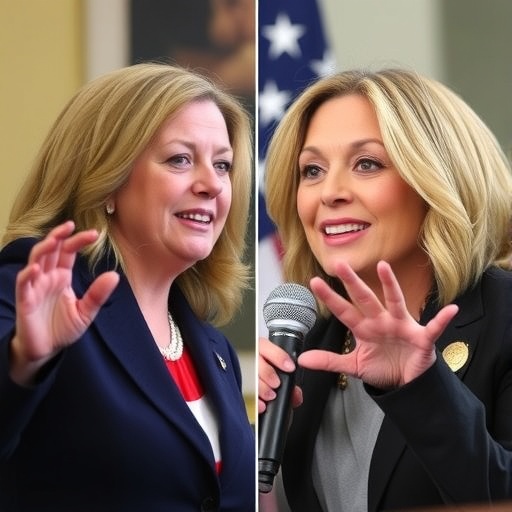Virginia Historic Election: Spanberger vs. Earle-Sears in Battle for First Female Governor
In a race poised to shatter glass ceilings across the political landscape, Virginia voters are heading to the polls in what could be the state’s most transformative gubernatorial contest in decades. Democrat Abigail Spanberger and Republican Winsome Earle-Sears are locked in a fierce battle, with the winner set to become Virginia‘s first female governor—and in Earle-Sears’ case, potentially the nation’s first Black woman to hold such an office. This historic election in Virginia isn’t just about policy; it’s a milestone for representation, drawing national attention as the Commonwealth edges closer to a November showdown.
- Spanberger’s Journey: From Farm to Frontlines of Congress
- Earle-Sears’ Bold Ascent: Marine Grit Meets Political Fire
- Battleground Issues: Education, Economy, and Equity in the Spotlight
- Polling Tightens: Voter Turnout and Swing Districts in Play
- Legacy in the Making: Implications for Virginia’s Future Leadership
The stakes couldn’t be higher. Virginia, a battleground state that has swung between parties in recent cycles, last elected a Republican governor in 2021 with Glenn Youngkin. Now, as term limits prevent Youngkin from running again, the governor’s mansion in Richmond beckons to two formidable women whose campaigns have mobilized voters on issues from education to economic recovery. Polls show a nail-biter, with Spanberger leading narrowly by 3 points in the latest Washington Post survey, but Earle-Sears’ grassroots momentum could flip the script.
This isn’t merely a local affair. The outcome could signal broader trends in American politics, especially regarding gender and racial diversity in leadership. As one political analyst noted, “Virginia’s governor race is a microcosm of the nation’s evolving electorate.” With early voting already underway, excitement is building, and experts predict record turnout.
Spanberger’s Journey: From Farm to Frontlines of Congress
Abigail Spanberger’s path to the governor’s race reads like a classic American success story, blending rural roots with high-stakes national service. Born in Red Bank, New Jersey, in 1979, Spanberger moved to Virginia as a young girl, growing up on a family farm in Short Pump. Her early life instilled a strong work ethic; she often speaks of milking cows before school and learning the value of community from her parents, both educators.
After earning a degree in speech communications from the University of Virginia, Spanberger didn’t shy away from adventure. She joined the CIA in 2006 as an operations officer, serving undercover in assignments that took her around the world. “Those years taught me resilience and the importance of intelligence in protecting our democracy,” Spanberger said in a recent campaign stop in Fairfax. Her intelligence background became a cornerstone of her 2018 congressional run, where she flipped Virginia’s 7th District from red to blue, defeating incumbent Republican Dave Brat by emphasizing national security and bipartisan problem-solving.
Now in her fourth term in the U.S. House, Spanberger has built a reputation as a moderate Democrat. She’s championed legislation on veterans’ affairs, drawing from her own family’s military ties—her husband is a former federal law enforcement officer. Key achievements include co-sponsoring the VA MISSION Act, which expanded healthcare access for veterans, and pushing for postal service reforms amid rural Virginia’s delivery challenges.
In the gubernatorial race, Spanberger has leaned into her Virginia roots, promising to invest in education and infrastructure. “As governor, I’ll fight for every Virginian, from the farms of Henrico to the tech hubs of Northern Virginia,” she declared at a rally in Richmond last week. Her campaign has raised over $25 million, per Federal Election Commission filings, outpacing Earle-Sears in fundraising but facing criticism from conservatives for her votes on gun control and climate initiatives.
Critics, including Earle-Sears’ team, portray Spanberger as too aligned with Washington insiders. Yet supporters highlight her 2020 reelection victory by 1.8 points in a Trump-won district, proving her crossover appeal. As Virginia’s historic election unfolds, Spanberger’s story resonates with suburban women and independents, groups that flipped the state blue in 2019 legislative races.
Earle-Sears’ Bold Ascent: Marine Grit Meets Political Fire
Winsome Earle-Sears embodies the unyielding spirit of a trailblazer, her life a testament to overcoming odds in pursuit of the American dream. Born in Kingston, Jamaica, in 1964, Earle-Sears immigrated to the U.S. at 19 with little more than determination. She enlisted in the U.S. Marine Corps, becoming one of the first Black women to serve in the branch’s aviation operations. “The Marines didn’t care where I came from; they cared what I could do,” she recounted in her 2021 victory speech after being elected Virginia’s first Black female lieutenant governor.
After her military service, Earle-Sears earned degrees in economics from Old Dominion University and in law from Regent University. She built a career as a business owner, logistics manager, and advocate for veterans and small businesses. Her political entry came in 2002, running unsuccessfully for the Virginia House of Delegates, but she persisted, serving on the Northampton County Board of Supervisors and founding the Honey Butter Cafe, a nod to her Jamaican heritage.
Earle-Sears’ 2021 win as lieutenant governor was seismic: she broke barriers as the first woman and first Black woman in that role, defeating Democrat Hala Ayala in a razor-thin margin. As Lt. Gov., she’s presided over the state Senate with a gavel that symbolizes progress, casting tie-breaking votes on bills ranging from tax cuts to election integrity measures. “I’ve always fought for freedom—first in the Corps, now in the Commonwealth,” Earle-Sears told Politico in an exclusive interview.
In her bid for governor, Earle-Sears is pitching a conservative vision: lower taxes, school choice, and tough-on-crime policies. Her campaign has surged with endorsements from national figures like Sen. Tim Scott and former President Donald Trump, who called her “a warrior for Virginia values.” Fundraising stands at $18 million, bolstered by small-dollar donations from Black conservatives and evangelical voters. Polling shows her strength in rural areas and among Black Virginians, where exit polls from 2021 indicated 12% support for Republicans—up from prior cycles.
Opponents label her an extremist on abortion and voting rights, but Earle-Sears counters with personal stories of faith and family. If elected, her victory would echo nationally, inspiring diverse candidates and challenging the GOP’s image on inclusion. As Virginia’s governor race heats up, Earle-Sears’ narrative of immigrant success is captivating undecideds.
Battleground Issues: Education, Economy, and Equity in the Spotlight
Virginia’s gubernatorial showdown is as much about policy clashes as historic firsts. At the forefront: education reform, a perennial hot-button after the 2021 Youngkin win capitalized on parental rights fervor. Spanberger advocates expanding pre-K funding and teacher pay, citing Virginia’s 45th national ranking in per-pupil spending by the Education Data Initiative. “Our kids deserve world-class schools, not culture wars,” she argued during a debate in Norfolk, proposing a $2 billion education bond.
Earle-Sears, conversely, pushes parental empowerment, including vouchers for private and charter schools. Drawing from her Marine discipline, she emphasizes STEM curricula and anti-woke initiatives, vowing to ban critical race theory in classrooms—a stance that polled at 55% approval among Republican-leaning voters in a Quinnipiac survey. The divide underscores Virginia’s suburban shift: Loudoun County’s school board battles drew national headlines, with parents mobilizing against equity policies.
Economy takes center stage too. Virginia’s unemployment hovers at 3.1%, per U.S. Bureau of Labor Statistics, but inflation bites. Spanberger touts job growth in green energy, aligning with Biden’s infrastructure bill that funneled $7.5 billion to the state. She promises tax credits for renewable projects, targeting the booming data center industry in Prince William County.
Earle-Sears counters with pro-business deregulation, aiming to cut corporate taxes from 6% to 5%. “Virginia’s economy thrives when government gets out of the way,” she stated at a Richmond business forum. Her plan includes workforce training for trades, appealing to blue-collar voters in Southside Virginia, where manufacturing jobs have declined 15% since 2010.
Equity issues, including abortion rights post-Dobbs, energize bases. Spanberger supports codifying Roe protections, while Earle-Sears favors state restrictions after 15 weeks. Gun violence, after 2023’s Richmond shootings, sees Spanberger backing universal checks; Earle-Sears focuses on mental health funding. These debates, amplified by $50 million in ad spending, are swaying independents, who comprise 35% of Virginia’s electorate per voter rolls.
Polling Tightens: Voter Turnout and Swing Districts in Play
As Election Day nears, Virginia’s governor race remains a toss-up, with polls reflecting a polarized yet energized electorate. The New York Times/Siena poll from late October shows Spanberger at 48%, Earle-Sears at 45%, and 7% undecided—a margin within the 3.2% error. This echoes 2017’s narrow Democratic win, but with higher stakes given Virginia’s purple status.
Key swing districts include the 7th Congressional District, Spanberger’s former turf, where independents lean 52% toward her on education per a Christopher Newport University poll. Northern Virginia suburbs, home to 40% of voters, favor Democrats by 8 points, driven by young professionals. Yet, rural Hampton Roads and the Shenandoah Valley bolster Earle-Sears, with 60% GOP support in exurban areas.
Turnout projections are sky-high: early voting surged 25% over 2021, per the Virginia Department of Elections, fueled by absentee ballots from military families. Black voter participation, at 18% of the electorate, could tip scales—Earle-Sears courts them with economic empowerment talks, while Spanberger mobilizes via NAACP partnerships.
National implications loom. A Spanberger win bolsters Democrats’ midterm hopes; Earle-Sears’ victory energizes the GOP base ahead of 2024. Pundits like CNN’s Van Jones predict “record-shattering engagement,” with youth turnout up 30% in college towns like Charlottesville.
Legacy in the Making: Implications for Virginia’s Future Leadership
Whoever claims victory in this historic election will redefine Virginia’s political horizon. A Spanberger governorship could accelerate progressive shifts, from climate action—targeting the state’s 2024 carbon neutrality goal—to expanding Medicaid, covering 200,000 more residents. Her administration might prioritize broadband access in rural counties, where 15% lack high-speed internet, fostering economic parity.
Earle-Sears as governor promises a conservative renaissance, potentially advancing school choice statewide and streamlining business permits to attract 50,000 new jobs. Her focus on veteran services could elevate Virginia’s military communities, home to 1.3 million service members and families.
Beyond policy, the winner’s identity matters. Virginia’s first female governor would join a select club—only nine states have elected women to the top job. If Earle-Sears prevails, she’d inspire Black women nationwide, where representation lags: just 4% of governors historically have been women of color.
Looking ahead, this race sets precedents for 2025 midterms and beyond. Expect ripple effects in neighboring states like North Carolina, where similar dynamics brew. As ballots are cast, Virginia stands at a crossroads, ready to etch a new chapter in its storied history of innovation and inclusion.








